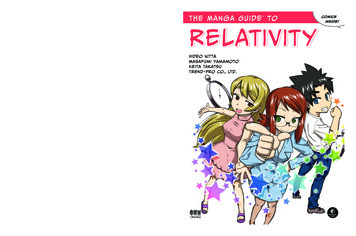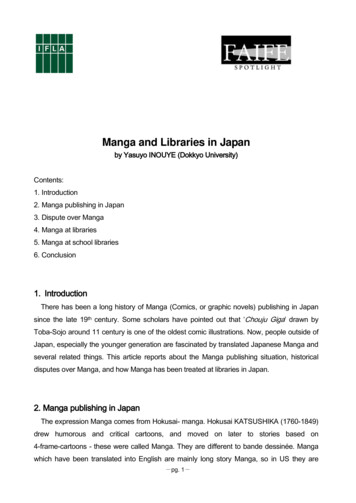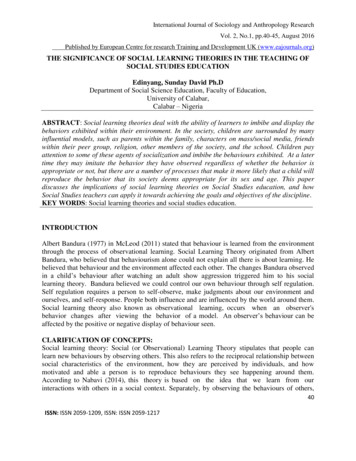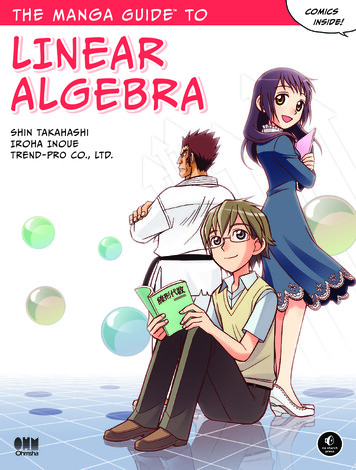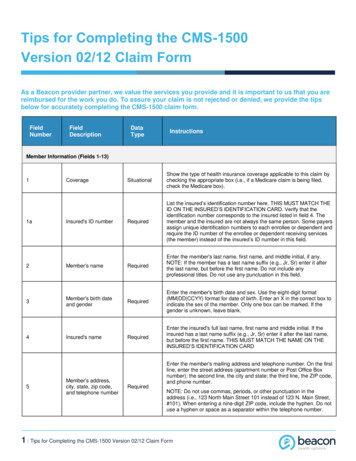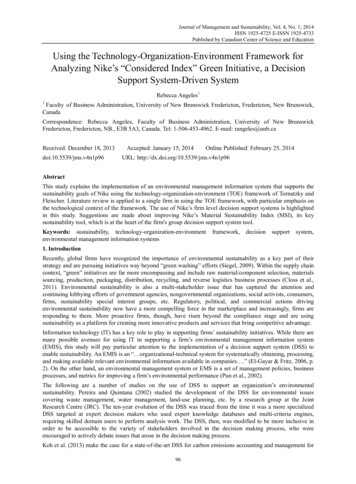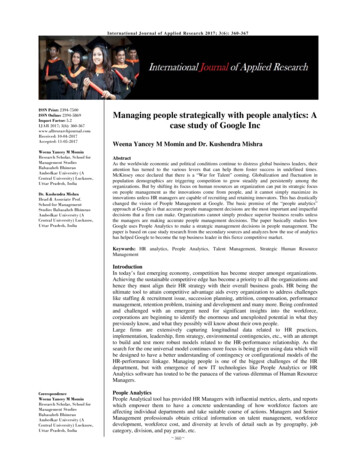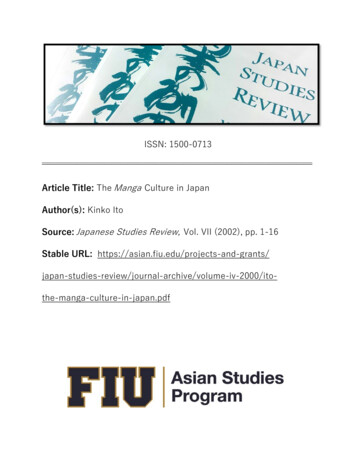
Transcription
ISSN: 1500-0713Article Title: The Manga Culture in JapanAuthor(s): Kinko ItoSource: Japanese Studies Review, Vol. VII (2002), pp. 1-16Stable URL: -manga-culture-in-japan.pdf
THE MANGA CULTURE IN JAPANKinko ItoUniversity of Arkansas at Little RockMany contemporary foreign visitors and observers have noticed theprevalence, ubiquity, and popularity of manga, or comics, in Japan. Mangais generally defined as:(1) “A picture drawn in a simple and witty mannerwhose theme is humor and exaggeration;(2) A caricature or a ponchie (ponchi picture), whosespecial aim is social criticism and satire;(3) That which is written like a story with manypictures and conversations.” (Shinmura 1991: 24-34)Manga as pictures and texts has traditionally been a significant part ofJapanese popular culture, entertainment, art form, and “literature.”Generally manga can be classified into many different categories such aseditorial cartoon, sports cartoon, daily humor strip, advertising cartoon, spotcartoon, syndicated panel, magazine gag, caricature, comic strip, etc.(Mizuno 1991: 20-21) Being textual sources and a significant part ofJapanese popular culture, manga can be an extremely important subjectmatter of comparative cultural studies, anthropology, and visual sociology.A Brief HistoryJapan has a very long history of comics that goes back to ancient times.It seems that the Japanese have always enjoyed drawing and looking atpictures and caricatures. For example, Hôryûji Temple in Nara was built in607 CE; it burned in 670 CE, and was gradually rebuilt by the beginning ofthe eighth century. It is the oldest wooden architecture in Japan, andprobably the oldest in the world as well. Caricatures were found on thebacks of planks in the ceiling of the temple during the repairs of 1935.These caricatures are among the oldest surviving Japanese comic art.Chôjyû Giga, or “The Animal Scrolls,” was drawn by Bishop Toba(1053-1140) in the twelfth century. The name of the scrolls literally means
2KINKO ITO“humorous pictures of birds and animals” and they depict caricaturedanimals such as frogs, hares, monkeys, and foxes. For example, a frog iswearing a priest’s vestments and has prayer beads and sutras, and some“priests” are losing in gambling or playing strip poker. The narrative picturescrolls are a national treasure of Japan. (Reischauer 1990; Schodt 1988;Shimizu 1991)A style of witty caricature called Tobae (“Toba pictures”) was startedin Kyoto during the Hôei Period (1704-1711). The name Tobae stems fromBishop Toba mentioned above, and it was used to refer to caricature. At thebeginning of the eighteenth century, Tobae books, which were printedusing woodblocks, were published in Osaka, a city center where publishingbusinesses were flourishing with a rapidly increasing population. From theGenroku Period (1688-1704) to the Kyôhô Period (1716-1736) so-calledAkahon (a Red Book which is a picture book of fairy tales such asMomotarô (The Peach Boy) with a red front cover) was very popular, andTobae books also became popular because they were like the variations ofAkahon. The publication of Tobae books spread to Kyoto, Nagoya, andEdo, modern Tokyo. This marked the beginning of the commercializationof manga in Japan. Manga then became a commodity to be sold to thepublic whether it was hand-drawn or woodblock printed. (Shimizu 1991)At the beginning of the nineteenth century, Katsushika Hokusai (17601849) started publication of “Hokusai Manga,” which became a bestseller.Hokusai was fifty-four years old, and he was the first to coin the termmanga. He was a very famous artist who left many masterpieces of multicolored Ukiyoe woodprints of sceneries such as “Fugaku Sanjû-rokkei,” or“The 36 Sceneries of Mt. Fuji,” prints of flowers and birds as well asdrawings of beauties and samurai. Hokusai Manga consisted of fifteenvolumes, and it started to permeate people’s everyday lives along with“Giga Ukiyoe” and newspapers with illustrations.“Japan Punch” was created and published in Yokohama in 1862 byCharles Wirgman (1832-1891), a British correspondent for the “IllustratedLondon News” from 1861 to 1887. Wirgman reported on the NamamugiIncident where some British men were killed by the samurai from Satsumanear Namamugi in 1862, the Satsuma—British War in 1863, which was aconsequence of the Namamugi Incident, the bombing of Shimonoseki bythe fleets of Britain, the US, France, and Holland (1863-1864), Harry SmithParke’s (the British ambassador to Japan) meeting with the last Tokugawa
THE MANGA CULTURE IN JAPAN3Shogun Yoshinobu in Osaka, etc. The events mentioned above happened atthe end of the Tokugawa Shogunate, and the conflict among the threepowers—the Tokugawa Bakufu Government, Anti-Bakufu and the westernnations, was a very appropriate subject for Wirgman’s manga.“Japan Punch” continued for twenty-five years and two-thousand-fivehundred pages, and was very popular among the foreigners living in theforeign settlements as well as the Japanese residents. The term ponchi(stemming from the English word “punch”) started to refer to what we callmanga today, and it replaced terms such as Tobae, Ôtsue, and Kyôga.Wirgman’s manga influenced many Japanese artists such as KyôsaiKawanabe. (Schodt 1988; Shimizu 1991)A French painter George Bigot started a magazine called “Tôbaè” inYokohama in 1887. It was a bi-weekly French style humor magazine thatsatirized Japanese government and society. Both Wirgman and Bigotinfluenced the development of modern Japanese comics. According toSchodt, “Wirgman often employed word-balloons [sic] for his cartoons andBigot frequently arranged his in sequence, creating a narrative pattern.”(Schodt 1988: 41)One of the most important functions of Japanese manga in its longhistory is satire, and the satire of authority was most dynamic during thecivil rights and political reform movement known as jiyû minken undô (“thefreedom and people’s rights movement”). The popular movement started atthe beginning of the Meiji Period (1868-1912). In 1875 Taisuke Itagaki,Shojiro Goto, Shimpei Eto, etc., submitted a proposal for the establishmentof the National Assembly. They had been highly influenced by theEuropean thinkers such as Jean Jacques Rousseau as well as the liberalBritish thoughts of the day. (Reischauer 1990; Shimizu 1991) The so-called“Manga Journalism” emerged at this time, and manga started to influenceJapanese political scenes as well. There were various factors thatcontributed to the emergence of mass production of manga satire in a veryshort time, among which are the advent of the technology of zinc reliefprinting, copperplate printing, lithography, metal type, photoengraving, andso on. The development of infrastructures such as transportation and mailservice, and heightening of the civil rights movement also contributed to theprocess. Manga became “a true medium of the masses.” (Schodt 1988: 41)The freedom and people’s rights movement was an anti-governmentmovement by speech, and manga played an important role as part of the
4KINKO ITO“speech.” The main media was a weekly magazine by Fumio Nomura.Nomura came from the samurai class from Hiroshima and he published“Maru Maru Chimbun,” a weekly satire magazine from the Dan Dan ShaCompany. The objects of Nomura’s satire were not limited to thegovernment. They included the Emperor and the Royal family, and theJapanese government often oppressed Nomura. The magazine increased itssales as the freedom and people’s rights movement became more popular.(Shimizu 1991)It was the 1920s through the 1930s when the modern Japanese mangastarted to establish itself and blossom. It was Rakuten Kitazawa (18761955) and Ippei Okamoto (1886-1948) who “helped popularize and adaptAmerican cartoons and comic strips.” (Schodt 1988: 42) Kitazawa drewmanga for “Box Of Curious,” an English language weekly published in theforeign settlements in Japan. It was Yukichi Fukuzawa who found his talentand Kitazawa started to work for the Jiji Shimpô Company in 1899.Kitazawa created “Tokyo Puck,” a weekly, color cartoon magazine in 1905.(Schodt 1988; Shimizu 1991)As far as the story manga is concerned it is only after World War IIthat it started to blossom. American comic strips such as: Blondie,Superman, Crazy Cat, Popeye, and Mickey Mouse and Donald Duck, weretranslated and introduced to Japan, a country that had been devastated bythe war. The people craved entertainment, and they longed for the richAmerican lifestyle that was blessed with material goods and electronicappliances.Starting in 1957, there appeared a new genre of manga called gekiga,or “drama pictures.” Artists such as Yoshihiro Tatsumi and Takao Saitostarted to refer to their art as gekiga rather than manga because their mangawas much like a novel with pictures. Gekiga appealed to junior and seniorhigh school students and later on university students as the readers aged.(Mizuno 1991; Shimizu 1991).In 1959 Kodansha, one of the largest publishing companies, started toissue “Shonen Magazine,” the first weekly manga magazine, and in 1966 itscirculation topped one million. Comics and television started to coexist insymbiotic relations, and many more weekly magazines followed “ShonenMagazine.” (Schodt 1988; Shimizu 1991)Manga and its Popularity Today
THE MANGA CULTURE IN JAPAN5In Japan, not only children but also many adults enjoy reading variouskinds of comics at home, school, and work. People also read manga inpublic places such as in trains and subways as they commute to work, in thewaiting rooms of hospitals, barbershops, and beauty salons, as well as ininexpensive restaurants and coffee shops as they wait for their orders.Manga café’s that offer many shelves of manga of various genres and aquiet space to read them for an hourly fee have been increasing in numberin the last few years. According to Television Asahi’s special on mangathat was broadcast on 15 October 1999, there are about three hundredmanga café’s in Tokyo alone, and lately they have been replacing anothertype of popular Japanese entertainment establishment called “karaokeboxes” where people can privately enjoy singing with family and friendsand order food and drinks.There are two major types of manga cafes: a coffee shop type and alibrary type. In the former customers order drinks and food, and they canread manga for free. In the latter the café charges customers’ hourly fees,and they can bring their own food or buy drinks in the vending machines inthe cafe. Many big manga cafes have twenty-five thousand to thirtythousand copies of manga. (“T.V. Asahi” 27 March 1998)So-called Manga Libraries are found all over Japan today, and manymunicipalities operate them. Manga museums and memorial halls ofvarious manga artists are also very popular, and they are often one of themeans for the villages, towns, and cities to attract tourists and make money.Omiya in Saitama Prefecture has the municipal manga memorial hallfor Rakuten Kitazawa, who became the first professional manga writer inJapan. It is the first publicly operated manga museum and opened in 1966.The admission is free. Kawasaki has a citizen’s museum that exhibits manymanga works. (Mizuno 1991)The city of Takarazuka has Osamu Tezuka Memorial Hall that containsall of the comic works by Tezuka (1928-1989) who created such popularicons as Astro Boy, Phoenix, Kimba, the White Lion, etc. One of thecharacteristics of Tezuka’s techniques was employing the same techniquesused in the cinema for his comics. Tezuka, who gave up his medicaltraining for manga, is considered the founding father of modern Japanesemanga. He was born at the right time in the right place. In its first year ofoperation in 1995 the Tezuka Memorial Hall had five-hundred-fortythousand visitors, and two-hundred-fifty thousand people visited the
6KINKO ITOmuseum in 1996. (“T.V. Asahi” 14 October 1997; Schodt 1988)Manga is often used as a facilitator for dissemination of information.Shin Fuji City government in Shizuoka created “Manga Fuji Story” thatdepicts and commemorates the city’s thirty-year history. (“T.V. Asahi” 7October 1996) Many prefectural government such as Fukui used manga inorder to explain their law of leaves for taking care of family members.(“T.V. Asahi” 17 May 1997)Interestingly enough, comics are more than popular entertainment inmodern Japan. So-called kyôyô manga, or “educational comics” are verypopular among the Japanese. These are drawn/written with a specificeducational purpose to teach the public certain subjects, technology, andinformation with manga drawings.In 1977 Hanazono, a private university used Jyoji Akiyama’s“Haguregumo” as part of its entrance examination questions, and a publicuniversity also incorporated kyôyô manga in 1984. In 1985 works byOsamu Tezuka and Sampei Sato were also used in elementary schooltextbooks for the Japanese language. The publication of a book byIshinomori Shotaro, “Nihon Keizai Nyûmon,” or “Introduction to JapaneseEconomy” followed. The book soon became a best seller, and this triggeredpublication of many more educational manga. “Introduction to JapaneseEconomy” was translated into English as “Japan Inc.,” and was publishedby the University of California Press in 1988, and its French version waspublished in Paris in 1989. (Shimizu 1991: appendix, 38-39) Interestinglythe Ministry of Education established a prize for manga in 1990. (Mizuno1991: 3)There are different opinions about educational manga. Many lamentthe decrease of intellectual activity when people “read” manga while otherssay that manga does provide very important information, and it makes iteasier to understand difficult concepts that are otherwise very hard to grasp.Pedagogically speaking kyôyô manga visually appeal to the comprehensionof difficult materials, and when it works it is indeed a very effective andpragmatic teaching method. Many foreigners living in Japan and learningthe language find manga a useful tool for studying reading and writingJapanese because of the use of ruby, notations of Japanese hiragana, aphonetic alphabet written next to the difficult Chinese characters. With orwithout manga Japan still boasts an illiteracy rate of less than one percentin the world.
THE MANGA CULTURE IN JAPAN7Kyôyô Manga books are comparable to the “Beginners” seriespublished in the US. They include many witty and comical drawings andexplanations. The examples are “Marx For Beginners” (1976) by Rius,“Lenin For Beginners” (1977) by Richard Appignanesi and Oscar Zarate,and “Foucalt For Beginners” (1993) by Lydia Alix Fillingham.Western social scientists, psychologists, and journalists have pointedout some of the problematic areas of Japanese comics such as sexism,violence, adult materials, pornography, etc., that are not suitable forchildren. Many PTA’s (Parent Teacher Association) and other concernedcitizen groups protested for the sake of innocent children claiming thatsome of the manga that are erotic, sexually explicit, and violent areeducationally and morally inappropriate for minors. The Japanesegovernment issued laws regulating the content and the ratings of comics inthe early part of 1990s. (Ito 1994) Several regional Boards of Educationestablished a rating system of putting “adult material” stickers for thosemanga appropriate for people over eighteen years old. These adult comicscannot be bought at a bookstore or a convenience store.Some conversations, customs, life styles, and games from popularmanga are used and imitated by the readers to spice up their ordinary everyday lives, or to make them more humorous. However, some ended up ascriminals. In 1997 some junior high school students started to engrave theirarms with knives. This “game” came from a manga that depicted a boy whoengraved letters on his arm with a knife. He then let a girl touch them, andshe would fall in love with him. This game called Inochi bori (life-tattoo)was popular in the spring of 1997. The school prohibited their studentsfrom bringing knives to school, but a seventh grade student killed a femaleteacher with a knife in Tochigi in the same year.An ex-employee of a loan company was arrested for extortion in 1999.He needed to collect money from his client, and he intimidated the latter bysaying, “Sell your kidney. I think I can sell it for three million yen orsomething. Your eye can be sold for million yen.” The police found that thesuspect got the idea from a scene in a manga called “Minami no Teiô”(“The King of Minami”). (“Yomiuri” 4 October 1999) The above casestestify that manga does have much influence on the social and cultural lifeof Japanese either positively as in the case of kyôyô manga or negatively asin the criminal cases imitating incidents from manga.
KINKO ITO8Manga as Big BusinessComic books and magazines are widely read regardless of sex, age,education, occupation, and social classes. Manga indeed is one of the mostpopular pastimes of people. Thus, the comics industry is one of the mostsuccessful and lucrative businesses in Japan today.In 1998 the total number of comic magazines published in Japan wastwo hundred seventy-eight brands, and the number of the estimated copiespublished, including special and extra issues, was 1,472,780,000 copies.This was 2.8% less than that of the previous year. The estimated number ofcopies sold is 1,177,850,000, down 3.2% from the previous year (“ShuppanShihyo Nempo” 1999: 223). T.V. Asahi Broadcasting Company in Tokyoquoted that the total number of publication in Japan is about 5.48 billioncopies and the share of comics’ sales consists of about twenty-five percent,or 1.7 billion copies. This means 4,650,000 copies are sold every day.(“T.V. Asahi” 15 October 1999)Weekly comic magazines in Japan usually have a few to severalhundred pages printed on rather cheap, coarse, and poor quality paper. Themagazines are easily disposable and recyclable. Japanese very rarely keepthem stacked up in their small houses once ridiculed by a European officialas the “rabbit hutch.” Some extra or special issues of manga magazines areas thick as the white pages of metropolitan cities in the US. The averageweekly magazine has between eight and fifteen stories or episodes byvarious authors, and the cost is about two US dollars. The comic magazinesin general also contain readers’ pages, advertisements of interesting goods,cigarettes, fashionable clothes, jewelry, shoes that make men three inchestaller, etc. Adult comics also have advertisements for X-rated movies andvideos as well as telephone clubs and “escort” and dating services. Theymay also have photographs of young, seductive, pretty women in scantyclothes or half-naked women.The Japanese market for comics is indeed gigantic. Japan is a very rarecountry where comics are a major business. Weekly and monthly comicmagazines sell millions of copies in a year, and so-called mangaka or comicwriters are among the richest people in Japan whose annual incomesurpasses millions of dollars. The following lists the estimated copiespublished by the most popular magazines.PublisherBrandReadersEstimated Copies
THE MANGA CULTURE IN hogakukanKodanshaShueisha(Nempo 1999)“Shukan Shonen Magazine” boys“Shukan Shonen Jump”boys“Young Jump”adults“Shukan Shonen Sunday” boys“Korokoro Comic”boys“Big Comic Original”adults“Young 350,000Some famous manga artists are millionaires. In 1999 Gosho Aoyama,Fumiya Sato, Akira Toriyama, and Oda Eiichiro, all earned millions ofdollars. (“T.V. Asahi” 17 May 1999) It is estimated that three hundredthousand to four hundred thousand people want to become manga artists.(Mizuno 1991: 75)Manga is truly a popular culture not only in terms of its consumptionbut also in terms of the creation process. Unlike cinema and theater thatrequire much capital and human resources to be popular and economicallysuccessful, manga does not require as much investment, formal education,good connections and so on. (Ishinomori 1998; Schodt 1988)The tools necessary to draw manga are pencils, knives for sharpeningpencils, erasers, pens, ink, brush, rulers, compass, white out, paints, paper,etc. Manga also is capable of depicting any scenes because its twodimensional format is capable of expressing anything a writer desires in hisor her imagination even though it is really up to the ability of the creator tomake it a masterpiece. The so-called “story manga” reads like a movie,which often was not made due to the lack of funds. (Ishinomori 1998; “T.V.Asahi” 1999)Sexism in ComicsIn Japan and elsewhere sexism, taxes, and death go together. Sexism inmanga is no exception. Western observers, journalists, and social scientistshave noticed that adult and youth comic magazines for men contain muchmale violence toward and maltreatment of women. (Bornoff 1991; Burma1985; Ito 1994, 1995; Schodt 1988; Wolferen 1989)Japanese women are depicted as having many Caucasian facial andbody features that are exceptionally pleasing to Japanese aesthetics. They
10KINKO ITOhave large, round, and shining eyes that usually take up one-third to a halfof the face, long and thick eye-lashes, long noses, thin pretty lips,unproportionaly large breasts, extremely small waistlines, and exceptionallylong thin legs.The weekly magazines for men often depict women as nothing morethan commodities or sex objects, and sex appeal is a must in drawing thesecharacters. They are often naked, but the frequent scenes of the process ofundressing also appeal to Japanese male fantasy. (Ito 1995)Nudity and sex sell very well in comics for men; voyeurism is also verycommon. Women must be seductive and close-ups of female bodies arevery common: breasts, thighs, hips, crotches, bottoms, and vaginas that areoften substituted with a picture of a clam or a flower. Interestingly, a snakeor a turtle is often used to depict a penis in manga.Interestingly enough Japanese men are depicted in two different ways:one type is those who have more good-looking Caucasian facial featureswith large, well-built bodies, long legs, and muscles that many youngJapanese men desire. These male figures are kakkoii, or cool andsophisticated.The ideal facial and body types are possibly a reflection of what RobertChristopher (1983) calls “the Gaijin complex,” which is an inferioritycomplex or very deep ambivalence that Japanese people feel towardforeigners (particularly Caucasians).The other types of Japanese men depicted in manga are more true totheir racial characteristics with small, slanted eyes, long trunks, slenderbodies, and short, hairy, and skinny legs. The former type, the more idealone, appeals to the fantasy of the readers who can vicariously experiencethe wonderful lives of those extremely handsome heroes. The latter type,which is more realistic, makes the reader identify with and relate better tothe characters.As in many popular storybooks, novels, and movies produced in Japanand elsewhere, men are often the main characters who are important to thestory lines and women are often bystanders and cheerleaders. The men haveunique, wonderful qualities—character, aspirations, dreams, goals, andcareers in such occupations as sumo wrestling, boxing, baseball, golf,medicine, crime prevention, cuisine, cycling, and even crime (e.g.,gangsters). The men occupy positions of power, privilege, status, andprestige. They are always in control. Women, on the other hand, are often
THE MANGA CULTURE IN JAPAN11housewives, office workers, or girlfriends.Many of the female characters play supportive roles at best. They donot show much personality and do not have their own opinions. If womenare depicted in careers they are usually those in pink-collar occupationssuch as waitress, secretary, nanny, student, saleswoman, nurse, teacher, etc.,even though many women in modern Japan are career women and aremarried to their occupations. The career women such as executives,detectives, photographers, spies, and television newscasters are oftendepicted as independent, intelligent, diligent, but also cunning,sophisticated, assertive, calculative, proud, and even violent.Women in adult manga for men are depicted as having docilepersonalities. They are beautiful, innocent, quiet, obedient, kind, warm, andnurturing. They show much concern for their men whether they are theirhusbands, boyfriends, lovers, bosses, brothers, fathers, etc. The womenaccept their men as they are, respect them, and cater to their needs withmuch tolerance and patience. They want to help the men by all means whenthey are in trouble. At the same time some women are nothing butnymphomaniacs. They are sexually liberated, quite passionate and initiativewhen it comes to making love, and they may even engage in self-eroticismand sex with multiple partners. They are good at seducing men as if to testtheir feminine power, and of course a Japanese man loves to become herprey! (Ito 1994, 1995)In sum, Japanese women are depicted in stereotypical gender roles thathave two opposing sides. The angel type is soft, warm, and nurturing. Thebitch type is intimidating, assertive, aggressive, cunning, and cold, yet theyare very sexy.Interestingly enough, there are many manga stories that are quiteeducational, informational, and beneficial for men. These include storiesthat revolve around the professional training, mental and psychologicalgrowth of the heroes, their lifestyles, philosophies, and doggeddetermination to be the best and win. The popular manga includeoccupations such as baseball player, brain surgeon, chef, serial killer,adventurer, sports-car driver, police officer, boxer, archeologist, etc. Manyhave few, if any, female characters in the stories, and the focus is more onthe personality, psychology, learning, and socialization of the male heroesas they solve many problems of life.
12KINKO ITOLadies’ ComicsThere is a genre of comics which is called Rediisu Komikku, or“Ladies’ Comics” that was established as a genre of manga in Japan in theearly 1980s. Ladies’ comics are very popular among women between theages of fifteen and forty-four, and enjoy a wide market. The readers buy themanga in a nearby bookstore or convenience store, and usually they buyseveral different manga magazines at one time. The readers, however, donot read these comics as a hobby per se but mainly to kill time. (Erino1993)According to Erino (1993) who used to be an editor of one of theladies’ comic magazines, a typical heroine in these comics does not have astrong identity or the self as an independent individual. She does not valueherself. She thinks she is not really worth anything, and she is not quite sureabout the meaning of her life. However, sooner or later a prince charmingwill show up at her door and sweep her off her feet. Marriage and sex sellvery well in Japan, too.Many Japanese women love the unordinariness in an ordinary everyday life in Japan that can be found in ladies’ comics. The key words fortheir success are often marriage, hypergamy, and finding a good-looking,cool, reliable, kind, sensitive, and loving man with a very nice income andsecurity that comes with his career. The man has money, fame, and socialstatus that the woman can also enjoy once she marries him. She mustremain beautiful and nurturing. He is the very reason why she exists in thisworld. The only requirement for her is to love her husband and children.(Erino 1993)The stories almost always have a happy ending, and many are nothingbut a Japanese version of Cinderella stories. Unlike Harlequin Romancenovels that depict the ultimate in romance and the possibility of theimpossible taking place in one’s mate selection, the stories in Japaneseladies’ comics are ordinary enough for the Japanese women to identify andrelate to. The fiction is more realistic, down- to-earth, and the majority ofheroines are so-called OL’s, or “office ladies” who work for companies anddo very menial jobs such as making copies and coffee.The OL’s who appear in ladies’ comic are not satisfied with theircurrent situations. Their lives are rather routine and boring. However, theydo not have anything particular that they really want to do or accomplish,either. Their lives lack excitement. (Erino 1993)
THE MANGA CULTURE IN JAPAN13As with comic magazines for men, the editors of ladies’ comics’magazines are almost always men. Certain male bias always shows up inthe stories. The messages carried in many manga are those that women arebetter off being married with children; women should go with the flow in amale-oriented Japanese society instead of against it; it is easier to rely on aman and belong to him; and so on. Much ambivalence is also foundbetween too much expectation for the young women to be independent andat the same time marry and have children, and between working as hard asmen and serving them by making tea or coffee in the office. Many heroinesexpect the role of a parent in men, and they often expect to be supportedfinancially and emotionally.Starting with the publication of “VAL” and “FEEL” in 1986, more andmore erotic and sexual scenes were drawn, and the trend escalated for along time. Ladies’ comics were often associated with female pornographiccomics then, but the frequency of sexual scenes subsided by the early1990s. Today, the major publishers such as Shueisha (“YOU”), Kodansha(“BE LOVE”), and Futabasha (“JOUR”) publish ladies’ comics that focusmore on the realistic everyday life stories, life-styles, careers, socialproblems, philosophies of life, and even compassion. Some stories thatappeared in the ladies’ comic that were published in the early part of 2000are quite touching. They invoke much emotion and heightening of socialand psychological awareness as if they are great novels. They are indeedsimple enough for anyone to understand; yet some are qu
books also became popular because they were like the variations of . Akahon. The publication of . Tobae. books spread to Kyoto, Nagoya, and Edo, modern Tokyo. This marked the beginning of the commercialization of . manga. in Japan. Manga. then became a commodity to be sold to the public wheth
